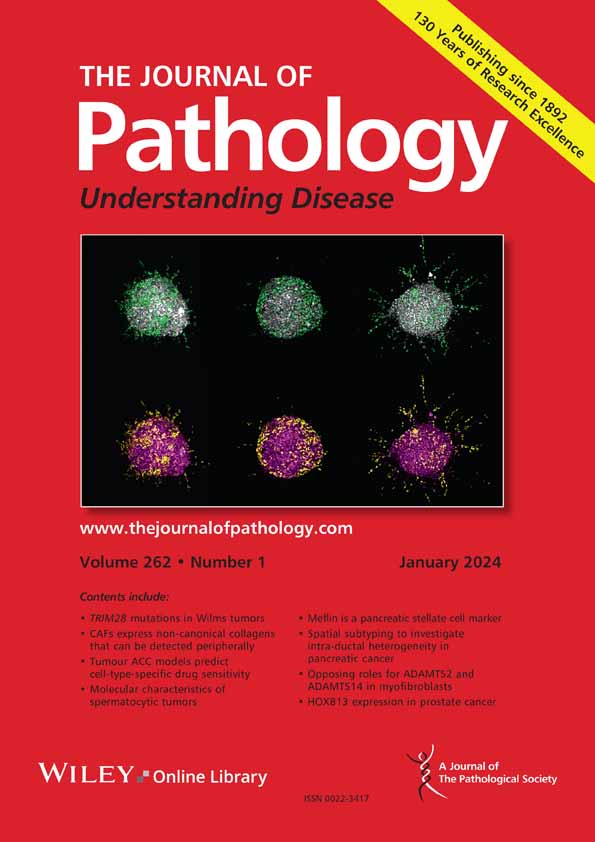Shouyi Tang, Qing Wang, Zhen Wang, Luyao Cai, Dan Pan, Jing Li, Qianming Chen, Yu Zhou, Ying-Qiang Shen
求助PDF
{"title":"NSD1突变状态通过调节线粒体呼吸决定头颈部鳞状细胞癌代谢抑制剂的敏感性。","authors":"Shouyi Tang, Qing Wang, Zhen Wang, Luyao Cai, Dan Pan, Jing Li, Qianming Chen, Yu Zhou, Ying-Qiang Shen","doi":"10.1002/path.6430","DOIUrl":null,"url":null,"abstract":"<p>Head and neck squamous cell carcinomas (HNSCCs) are the most common malignant tumors in the head and neck region, characterized by a high recurrence rate and early metastasis. Despite advances in treatment, patient outcomes and prognosis remain poor, highlighting the urgent need for new therapeutic strategies. Recent research has increasingly focused on targeting glucose metabolism as a therapeutic strategy for cancer, revealing multiple promising targets and potential drugs. However, the metabolic heterogeneity among tumors leads to variable sensitivity to metabolic inhibitors in different patients, limiting their clinical utility. In this study, we employed bioinformatics analysis, cell experiments, animal models, and multi-omics approaches to reveal differences in glucose metabolism phenotypes among HNSCC patients and elucidated the underlying molecular mechanisms driving these differences. Our findings showed that <i>NSD1</i> mutation status affects the glucose metabolism phenotype in HNSCC, with <i>NSD1</i> wild-type HNSCC exhibiting higher mitochondrial respiration and <i>NSD1</i> mutant HNSCC showing weaker mitochondrial respiration but enhanced glycolysis. We further demonstrated that <i>NSD1</i> regulates mitochondrial respiration in HNSCC via epigenetic modulation of the <i>TGFB2</i>/<i>PPARGC1A</i> signaling axis. Additionally, we found that <i>NSD1</i> wild-type HNSCC is more sensitive to mitochondrial respiration inhibitors, whereas <i>NSD1</i> mutant HNSCC shows increased sensitivity to glycolysis inhibitors. In summary, we found that <i>NSD1</i> can epigenetically regulate the <i>TGFB2</i>/<i>PPARGC1A</i> axis to modulate mitochondrial respiration and sensitivity to metabolic inhibitors in HNSCC. These findings suggest a novel strategy for selecting metabolic inhibitors for HNSCC based on the <i>NSD1</i> gene status of patients. © 2025 The Pathological Society of Great Britain and Ireland.</p>","PeriodicalId":232,"journal":{"name":"The Journal of Pathology","volume":"266 3","pages":"306-321"},"PeriodicalIF":5.2000,"publicationDate":"2025-05-15","publicationTypes":"Journal Article","fieldsOfStudy":null,"isOpenAccess":false,"openAccessPdf":"","citationCount":"0","resultStr":"{\"title\":\"NSD1 mutation status determines metabolic inhibitor sensitivity in head and neck squamous cell carcinomas by regulating mitochondrial respiration\",\"authors\":\"Shouyi Tang, Qing Wang, Zhen Wang, Luyao Cai, Dan Pan, Jing Li, Qianming Chen, Yu Zhou, Ying-Qiang Shen\",\"doi\":\"10.1002/path.6430\",\"DOIUrl\":null,\"url\":null,\"abstract\":\"<p>Head and neck squamous cell carcinomas (HNSCCs) are the most common malignant tumors in the head and neck region, characterized by a high recurrence rate and early metastasis. Despite advances in treatment, patient outcomes and prognosis remain poor, highlighting the urgent need for new therapeutic strategies. Recent research has increasingly focused on targeting glucose metabolism as a therapeutic strategy for cancer, revealing multiple promising targets and potential drugs. However, the metabolic heterogeneity among tumors leads to variable sensitivity to metabolic inhibitors in different patients, limiting their clinical utility. In this study, we employed bioinformatics analysis, cell experiments, animal models, and multi-omics approaches to reveal differences in glucose metabolism phenotypes among HNSCC patients and elucidated the underlying molecular mechanisms driving these differences. Our findings showed that <i>NSD1</i> mutation status affects the glucose metabolism phenotype in HNSCC, with <i>NSD1</i> wild-type HNSCC exhibiting higher mitochondrial respiration and <i>NSD1</i> mutant HNSCC showing weaker mitochondrial respiration but enhanced glycolysis. We further demonstrated that <i>NSD1</i> regulates mitochondrial respiration in HNSCC via epigenetic modulation of the <i>TGFB2</i>/<i>PPARGC1A</i> signaling axis. Additionally, we found that <i>NSD1</i> wild-type HNSCC is more sensitive to mitochondrial respiration inhibitors, whereas <i>NSD1</i> mutant HNSCC shows increased sensitivity to glycolysis inhibitors. In summary, we found that <i>NSD1</i> can epigenetically regulate the <i>TGFB2</i>/<i>PPARGC1A</i> axis to modulate mitochondrial respiration and sensitivity to metabolic inhibitors in HNSCC. These findings suggest a novel strategy for selecting metabolic inhibitors for HNSCC based on the <i>NSD1</i> gene status of patients. © 2025 The Pathological Society of Great Britain and Ireland.</p>\",\"PeriodicalId\":232,\"journal\":{\"name\":\"The Journal of Pathology\",\"volume\":\"266 3\",\"pages\":\"306-321\"},\"PeriodicalIF\":5.2000,\"publicationDate\":\"2025-05-15\",\"publicationTypes\":\"Journal Article\",\"fieldsOfStudy\":null,\"isOpenAccess\":false,\"openAccessPdf\":\"\",\"citationCount\":\"0\",\"resultStr\":null,\"platform\":\"Semanticscholar\",\"paperid\":null,\"PeriodicalName\":\"The Journal of Pathology\",\"FirstCategoryId\":\"3\",\"ListUrlMain\":\"https://pathsocjournals.onlinelibrary.wiley.com/doi/10.1002/path.6430\",\"RegionNum\":2,\"RegionCategory\":\"医学\",\"ArticlePicture\":[],\"TitleCN\":null,\"AbstractTextCN\":null,\"PMCID\":null,\"EPubDate\":\"\",\"PubModel\":\"\",\"JCR\":\"Q1\",\"JCRName\":\"ONCOLOGY\",\"Score\":null,\"Total\":0}","platform":"Semanticscholar","paperid":null,"PeriodicalName":"The Journal of Pathology","FirstCategoryId":"3","ListUrlMain":"https://pathsocjournals.onlinelibrary.wiley.com/doi/10.1002/path.6430","RegionNum":2,"RegionCategory":"医学","ArticlePicture":[],"TitleCN":null,"AbstractTextCN":null,"PMCID":null,"EPubDate":"","PubModel":"","JCR":"Q1","JCRName":"ONCOLOGY","Score":null,"Total":0}
引用次数: 0
引用
批量引用




 求助内容:
求助内容: 应助结果提醒方式:
应助结果提醒方式:


